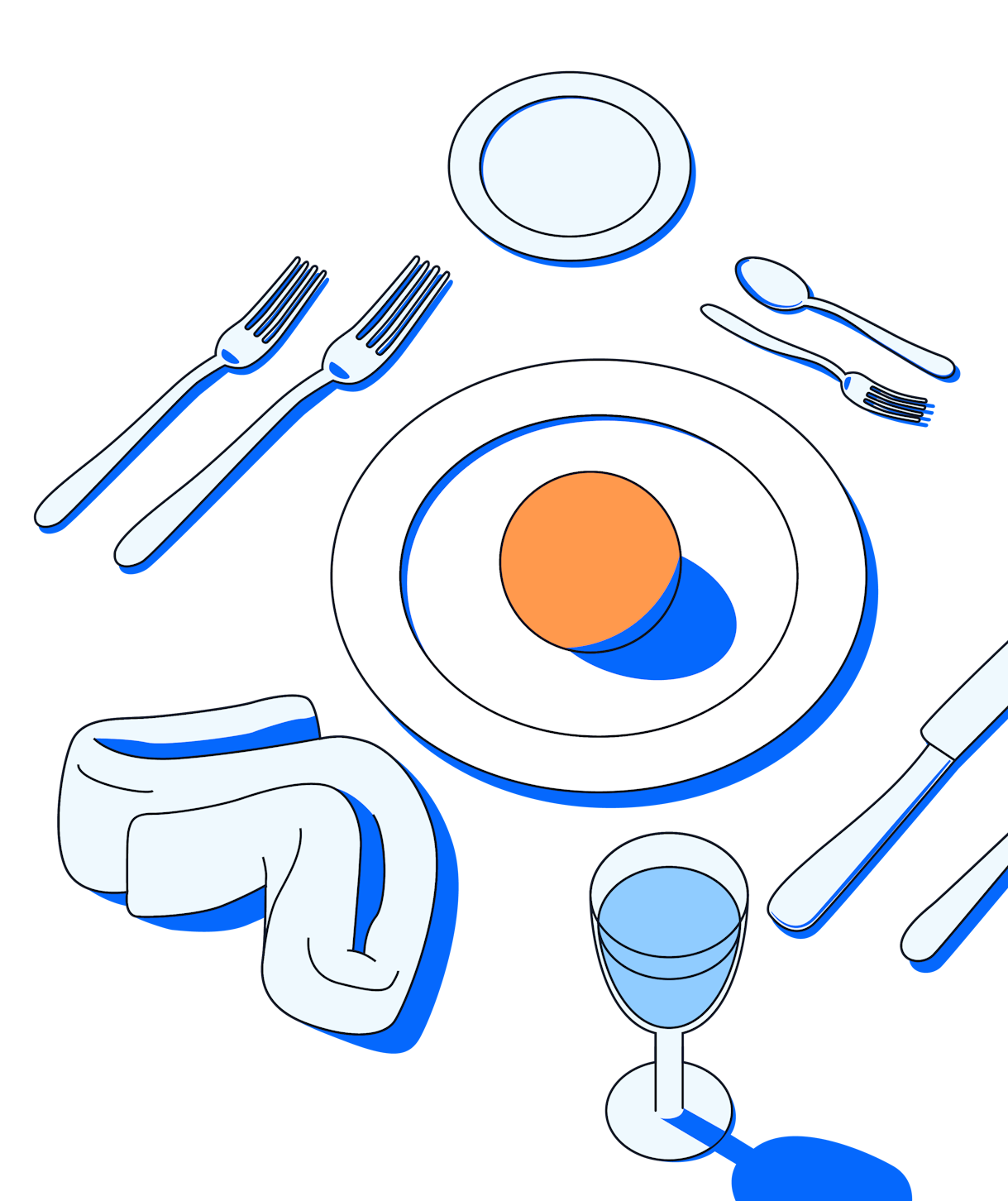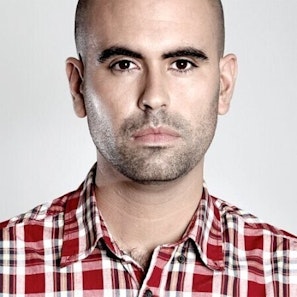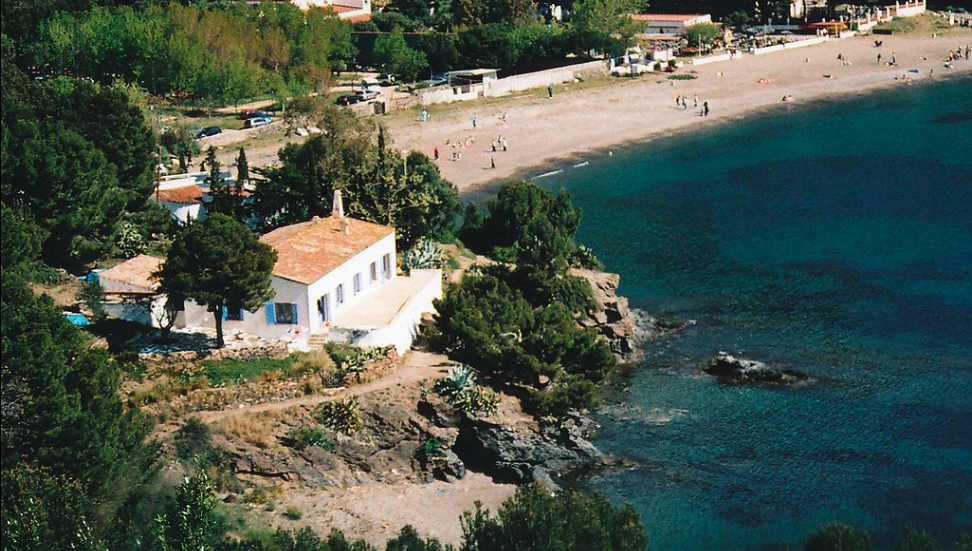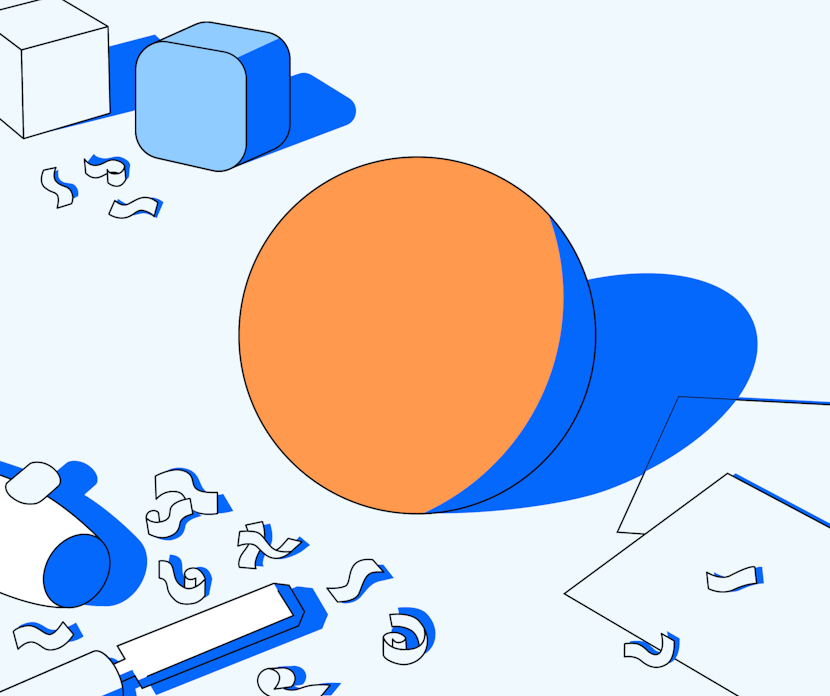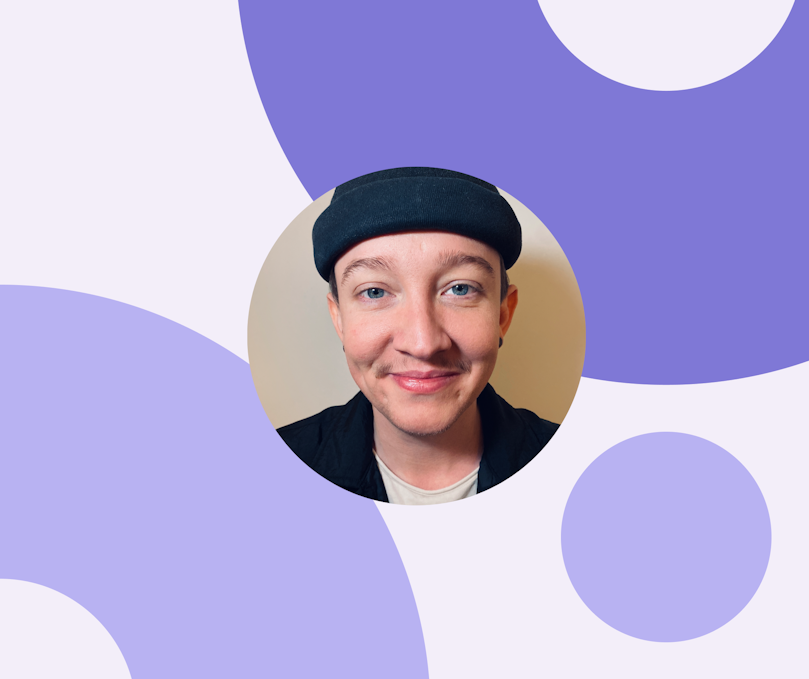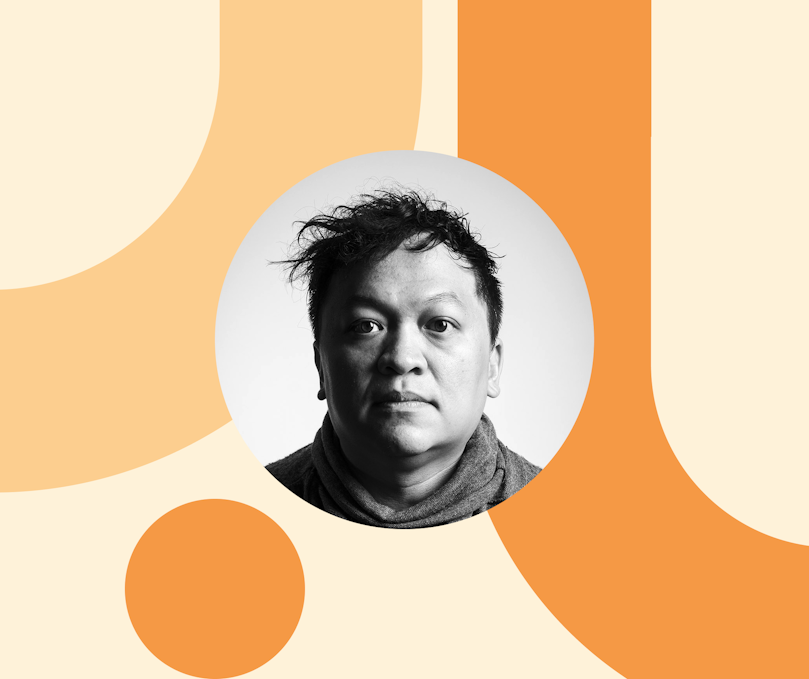When I joined Maze to lead Design, we were a small team of six talented product designers. We had a solid design foundation, but we lacked internal expertise in UX writing, and our design system was just getting off the ground. And with the Series A funding we’d received earlier in the year, things were ramping up fast.
Fast forward to today. Our team has more than doubled in size, with product designers, UX writers, and a DesignOps team managing our new design system. We also recently raised our Series B.
But growing a team isn’t just about hiring more people. It’s about rethinking the meaning of design across the company, and developing systems and processes that support each person within the team.
Experience Design may not yet be a household name, but the practice should be familiar to any mature user-centric company.
In this article, I’d like to give you a taste of three ingredients—people, processes, and goals—that go into our Experience Design team at Maze.
But first, let’s begin with a small gastronomical detour.
Great recipes lead to memorable experiences
I grew up in Barcelona on the Mediterranean coast. It’s less than two hours from the French border (where Maze was born), and about the same to the famous restaurant, El Bulli—the experimental brainchild of world-renowned chef Ferran Adrià.
Before the restaurant was transformed into a culinary workshop for the world’s top chefs, it had earned three Michelin stars, and was named best restaurant in the world a record five times.
The Guardian described El Bulli as "the most imaginative generator of haute cuisine on the planet." A key ingredient was molecular gastronomy—the scientific discipline of the physical and chemical transformations that occur during cooking.
Ferran Adrià is a cook. But he’s also been described as an artist, a scientist, an inventor, a stage director, and a designer. He’s the master of building memorable, irresistible dishes from the tiniest parts up.
But it’s more than just the food. The entire three-hour dining experience was crafted to delight every patron—from the ingredients and interactions with the staff, to the timing of the dishes and beautiful setting on the Mediterranean coast.
Growing up in Barcelona, and having a fond taste for good cuisine, I’ve been inspired to approach product design in a similar way. It’s much more than buttons, menus, and transitions between screens—it’s the sum of the entire experience a user has with our product. Our job is to understand our customer’s needs and desires, and then deliver a product that helps them design better products for their customers.
Much like running a world-class kitchen, it takes a little art, a little science, and a lot of teamwork directed toward shared goals.
Let me introduce you to how we do design.
Experience Design (XD) at Maze
When you think of design, what comes to mind?
Many people picture visual design: shapes and colors, graphics and logos. In this view, design is seen as an artistic discipline. But much like El Bulli’s rethinking of the culinary experience, the role of design in product-led companies continues to evolve.
There’s no one right way to run a design organization, but there are certain patterns you see as teams mature.
In many young, non-design-focused companies, you see designers reporting to marketing or engineering teams. This sets a narrow expectation of the role of these professionals.
As teams begin to grow and mature, it’s more common to see designers reporting into Product orgs. This might work for some, but having Product as the primary driver and influencer misses opportunities to leverage design thinking to build the best products.
Once design maturity and awareness grows, companies continue their evolution into experience design—or XD—teams, which takes a much wider view of the role, and meaning, of product design. It goes beyond thinking of design as decoration, and focuses on creating seamless, intuitive product experiences that customers love.
Experience design also integrates specialized UX writers, or content designers, so we can delight customers with clear, inclusive, and accessible language. It might include user research, to keep a direct ear on customer needs. And it also emphasizes internal processes, coordination, and consistency through dedicated design operations, or DesignOps, teams.

The strategic outlook of Experience Design at Maze
I’m happy to say that Maze is a truly user-centric organization with an appetite for design. This means that design isn’t just about polishing the shapes that engineers create, or coloring in the steps the Product teams specify. Design has influence and a seat at the decision table.
Alex Schleifer at Airbnb put it nicely with his three-legged stool analogy. Engineering, Product, and Design—or EPD—represent the three areas that help to build products. So in this model, the primary job of the Director/VP of Design is to create awareness for the discipline, and bring the function to life, alongside product and engineering leaders.
The goal of our XD team is to help make Maze as easy to use, effective, and efficient as possible. For us, that means designing a product experience that is:
- Accessible
- Predictable
- Consistent
- Visually appealing
- Human
Getting there requires a keen awareness of our users—how they think, and what they want to accomplish—along with our three main ingredients.
So grab a fork, and let’s dive in.
Ingredient 1: People, roles, and culture
When I first started at Maze, there were a few obvious challenges. One of them: we had four designers, two team leads, and way too much work.
Maze Tech group works in cross-functional teams called pods. Individual designers are embedded into vertical pods, alongside other product managers and engineering folks. Each pod serves a different part of the product—like activation, or workflows—so designers gain strong expertise in particular areas.
The problem was that people were spread too thin. On paper, the leads were acting as managers, but in reality they also continued to serve as individual contributors within different pods.
We also lacked any form of standardized design system to help support embedded designers. This gave me a few simultaneous issues to address:
- How do we structure the team?
- How do we create a culture where people can thrive?
- How do we hire new people into the team?
- How do we nurture and grow the talent we have?
Let’s take each of those in turn.
Structuring the XD team: a hybrid model
One of the biggest challenges of any organization is how to develop functionally effective teams while avoiding silos. A related challenge of cross-functional teams is how to provide discipline-specific support to individuals who are embedded in multidisciplinary pods.
Our approach to this is Design Operations: a transversal team supporting vertically-embedded designers.
This team is made up of visual and interaction designers, and UX writers. They help with feedback, project workflows, scaling processes, democratizing our design principles, and being available to jump in with specific skills when needed. There’s also a dedicated engineer who helps keep design and engineering in sync.
Our DesignOps team is also responsible for building and maintaining our design system—shared standards for managing design at scale by creating uniform language and visual consistency across the product. In other words, it helps us deliver consistent solutions more effectively.
Over the past six month, our Experience Design team has grown from six to fifteen people. Around half of the team is embedded in pods, with the rest in DesignOps, UX writing, or leadership roles.
Nurturing a supportive culture
I know what it’s like to have someone come in and say: “Here’s how we do things from now on.” It’s often done as a show of strength, but in reality it’s scary, uncertain, and counterproductive.
I strive to be a servant leader. I look at fostering a culture of empowerment and accountability, where individuals feel inspired by our mission and are motivated to work toward it.
Part of this includes surveying the team to find out what matters to them, and setting team OKRs where we can collaboratively work together toward a single goal.
Another focus is building a psychologically safe environment. We do this by building personal relationships, giving positive reinforcement, and candid feedback. I want everyone to understand—and believe—that this is a playground to try and test different ideas. To help, I often give examples of my own a-maze-ing failures to let people know this is okay.
I also encourage reading sessions. This is in part to fill gaps in specific skill areas. But it’s equally to provide the team with a common language to frame our work. A few of the specific books I recommend to the XD leadership team are:
- The Making of a Manager, by Julie Zhuo
- Unleashed, by Frances Frei & Anne Morris
- Radical Candor, by Kim Scott
- Org Design for Design Orgs, by Peter Merholz & Kristin Skinner
Most importantly, we empathize with each other, and jump in to help others when needed. And we’re not afraid of failure. Every opportunity that doesn’t go according to plan is a chance to learn and develop.
Scaling the team with purpose
In a small team, generalists are common. You need people who are able to shift to the changing demands. This flexibility remains important as teams grow, but it’s equally important to have the right people with specific skills and experience to fill gaps.
My approach to hiring is to step back and look at the existing team and company needs. You might call it organizational design.
I don’t say “I need five more designers asap to cover our different needs.” Instead, I see that, for example, we need a designer in our Growth pod. So we look for someone with the general profile we expect from all designers, along with more specific experience and acumen in the needed acquisition, activation, or monetization area.
What general skills do we look for when hiring designers? At Maze, it’s a three-pronged profile:
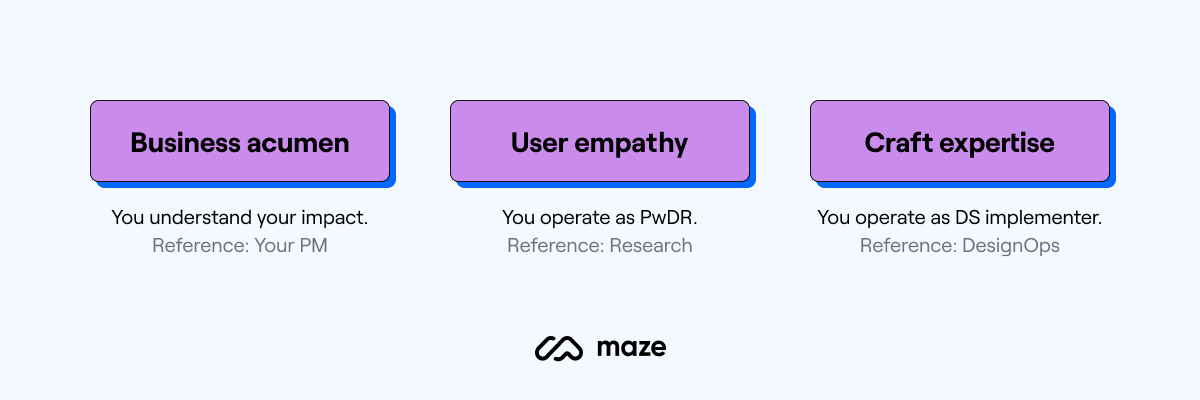
General skills we look for in designers at Maze
These also play into our evaluation lattices as we encourage personal growth across the team.
Developing talent: lattices, not ladders
No one comes into the team to remain exactly in the role they started. But that doesn’t mean that everyone develops in the same way.
So when a new person joins the team, we work together on a career development framework to help understand their aims and motivations. You can think about three general profiles:
- Climbers aim to move up the ladder and grow into a-maze-ing professionals
- Experts prefer to become increasingly specialized contributors, developing their expertise and going on to become references across the industry
- Explorers begin in one area (e.g. design), then sidestep into another (e.g. research)
This model focuses on lattices instead of ladders. Not everyone aims to climb the ladder, especially in a multidisciplinary team with so many opportunities to learn. So we provided frameworks that allow people to develop in the ways that best suit their interests and drives. It’s a flexible plan, not a formal sequence to step through.
We also complete competency matrices to help understand an individual's—and the team’s—strengths. We do this for both hard and soft skills.
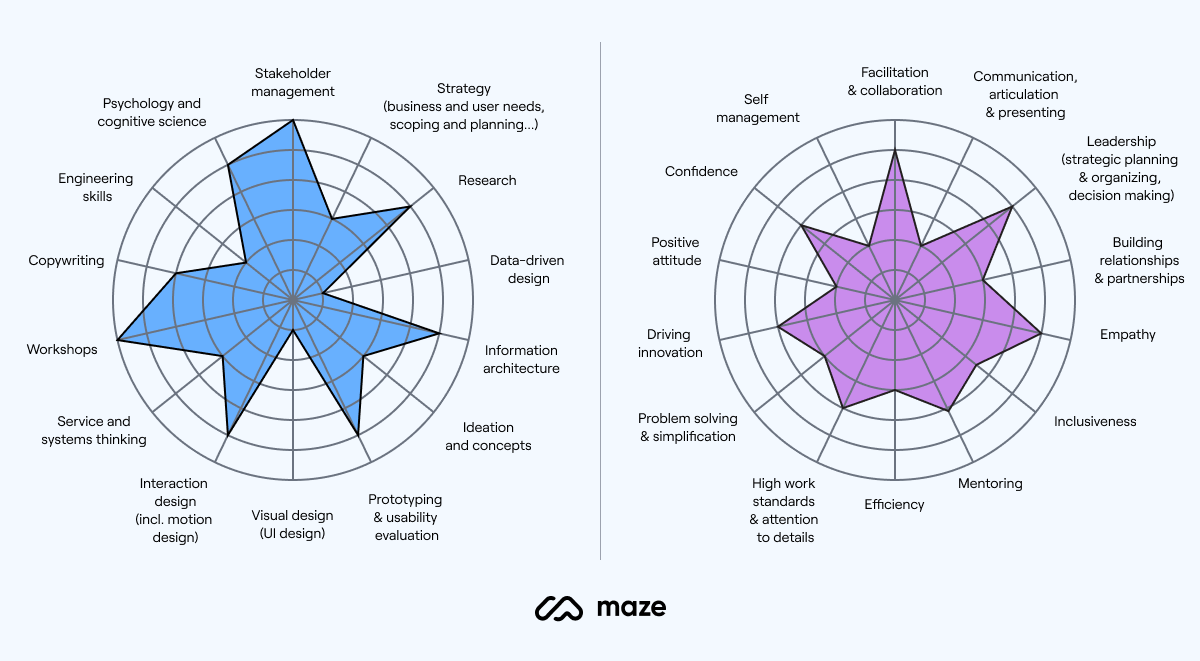
Hard (left) and Soft (right) skills mapping are part of our design growth model
Our goal is to help designers grow into the best versions of themselves, while also ensuring that our team is supporting the needs of the business.
By mapping strengths across different domains and skill sets, we can see areas where an individual may be best suited to work, and where they need to improve. Comparing across the team helps us see where we need to hire and where additional training is needed.
Skill mappings are transformed into SMART goals or OKRs, so each person on the team has a plan to grow. This also helps build the backbone of an individual's career ladder lattice.
While everyone’s career path may look different, seniority is similarly assessed. Simply put, the wider the audience impacted by someone’s work, the more senior they’re likely to be.
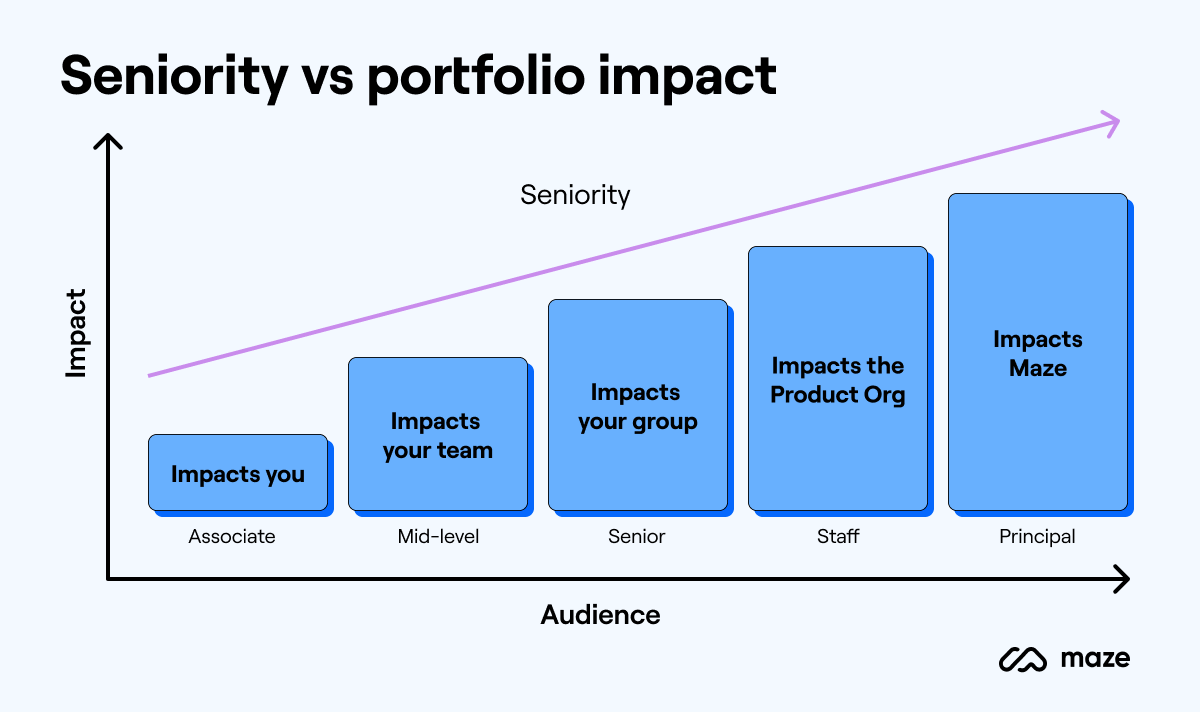
And with all these new people in the kitchen, we also needed to upgrade the operating system.
Ingredient 2: Scalable systems & processes
In one season, El Bulli served 8,000 lucky patrons with 42 chefs. Around 2 million people tried to book a table and were turned away. Despite unending enthusiasm to get a taste of El Bulli’s 250 euro menu, the restaurant lost money every year. Instead of focusing on growth and profit, they focused on the details of every curve, color, and texture.
Unfortunately, we don’t have that luxury in the tech industry. So the challenge for us is to build scalable systems that don’t compromise on quality. And that’s exactly what well-designed systems allow you to do.
It’s a challenge for teams of all sizes: how do we craft excellence at every touch-point while providing a coherent story across all areas of the product? Basically, how do we make sure our product experience doesn't feel like it’s been crafted by independently siloed teams?
Here are a couple of ways we do it at Maze.
Designing rituals that work for growing teams
“Fire! Fire!” Puff. Puff.
In a quickly scaling tech company, a lot of days feel like this. A problem arises, and you run to put it out. So I’m going to tell you how to completely eliminate this from your workflow.
Just kidding. Reacting to issues as they arise is part of the game. But you can also build in systems that proactively work to reduce firefighting. Here’s an overview of our approach. As you can see, from left to right activities move from more proactive to reactive.
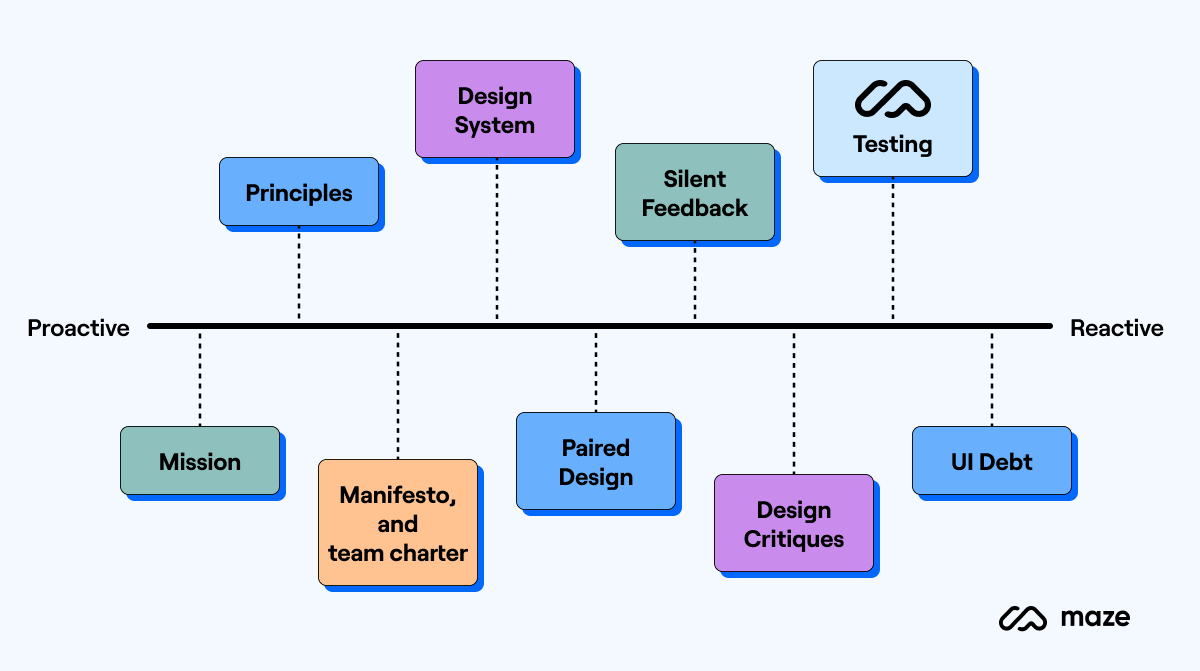
Proactive vs. reactive rituals
On the far left are things like our mission and principles. Being clear on why we exist and what we care about sets guidelines for everything we value and prioritize. For example, knowing that accessibility and consistency are unbending principles prevents us from designing an experience that’s detached from the rest of the user journey, no matter how cool we think it might be.
Moving right, you find things like our design system. This proactively enforces our principle of, for example, providing a consistent experience. By having design foundations, tokens, components, and patterns standardized, we reduce the risk of implementing inconsistency, even as we scale. But as our Design System leader, Alberto Calvo, put it: "A design system isn't a project, but a process.” So there are times when we need to react to a new situation by building new scalable components.
Further right still are our design critiques. These are opportunities to gather feedback to help evaluate ideas. They let us identify what’s working well, and what’s not, so we can improve the quality of work in progress.
And no matter the love put into the recipe, occasionally things go wrong in the kitchen. UI debt appears in the form of bugs or other oversights. So in partnership with Product and Engineering, we save time to reactively address things that have already gone into production.
This is only an appetizer of our approach to process, but it gives a taste of how we protect quality as we scale. The other thing we work to protect is time.
Communicating across time zones
Raise your hand if you love meetings? I can’t see you, but I’m guessing your hand didn’t go up.
The reason people don’t enjoy meetings isn’t because they don’t want to connect with coworkers. The problem, especially in distributed teams, is that people don’t want to be connected all the time. And in our case, we also have team members spread across multiple time zones. So running efficient, and effective, meetings that respect people’s time is essential.
That’s why our default mode of communicating is asynchronous.
Of course we still connect in meetings when needed. This is important for more sensitive topics, group feedback, and open-ended AMAs. But for more rational exchanges of information—like project updates or OKR planning—we go with async comms.
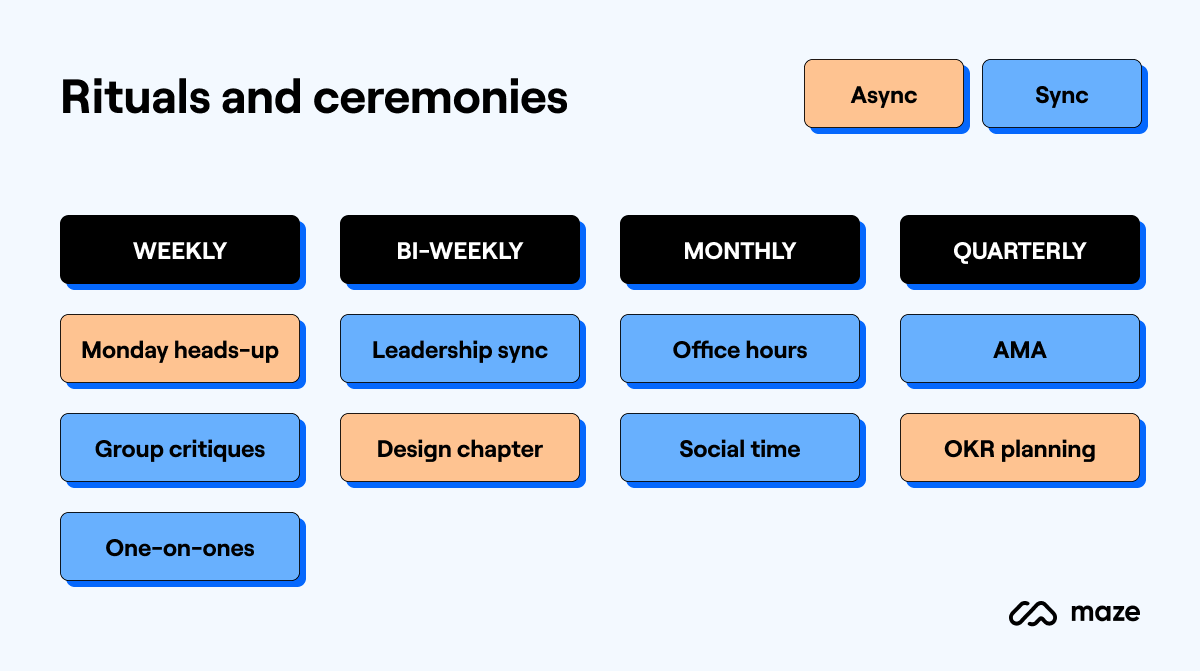
Async & sync design rituals at Maze
Reality is always more nuanced than models. So of course adjustments are made depending on context. And the more we work together to find that sweet spot, the more time we have to focus on designing better experiences.
Ingredient 3: Goals worth striving for
The last ingredient for today is impact. How do we know if our team is successful?
When we think about the goals and impact of design, it’s useful to think along two dimensions inspired by Intercom:
- Direct vs. Indirect: how unambiguously the value can be traced back to the work
- Non-measurable vs. Measurable: how easy a number can be placed on the work
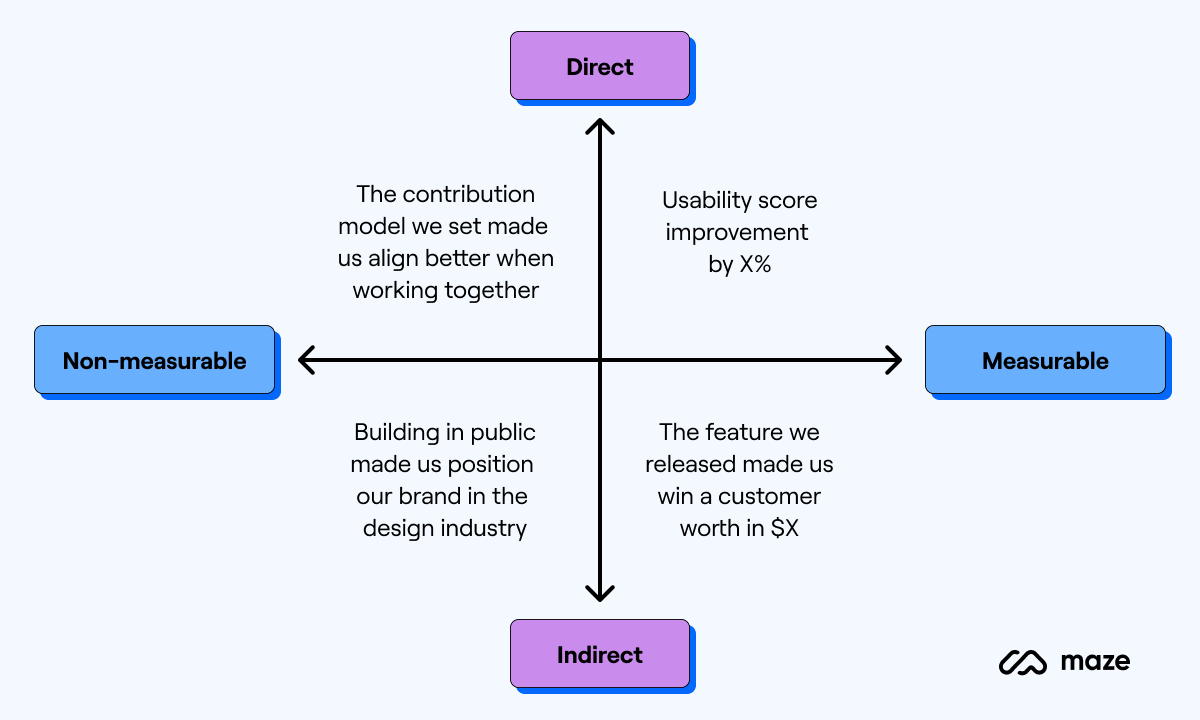
Our goals model at Maze
Each of these quadrants has value, but it’s important to understand where a particular initiative falls.
For example, if a product designer helps improve the viral growth loop on our Thank You screen, that has a measurable impact on the business. But its roots can be traced back to efforts from each leg in the EPD stool, along with the efforts of Marketing and Customer Success.
So is Experience Design contributing to company goals? Yes, in a measurable, indirect way.
As another example, our team developed an internal contribution model for us to create, track, rationalize, maintain, and improve how we manage projects. This had a direct impact on how we work together, though the metrics for defining this improvement were underspecified.
For individual impact and career development, goals take on a different form. At an individual level we might express impact with a simple formula:
Expertise x Performance = Impact
Expertise comes back to the customer empathy, business acumen, and craft skills mentioned above. Performance is how well someone plans, delivers, and communicates what they do. As these variables increase, so does their impact.
Also seen above, as people progress along their careers, their impact ripples out to larger circles of people. So regardless if someone is a climber, explorer, or expert, they should strive to increase their audience of impact.
And me personally? I hold myself to the same standard as everyone else.
As a servant leader, I want to help people do their best work by nurturing the skills and systems that allow this to happen. Do people feel empowered to succeed and grow? Are our processes nurturing confidence and trust? Do designers care about our mission? Are they recommending Maze to other designers? Is leadership still committed to Experience Design?
If any of these answers are ‘no,’ then I have work to do.
The art and science of Michelin-star design
Ferran Adrià has defined his mission as “the art of giving pleasure through food.” Similarly, we see our job as the art and science of giving pleasurable product experiences through design.”
Experience design travels way beyond pleasing shapes and textures to embrace scalable systems and human language.
We have a long way to go to reach Michelin-star design status. But we believe with the right ingredients, and a sharp focus on the customer, we’ll continue to design experiences that whet the appetite.
